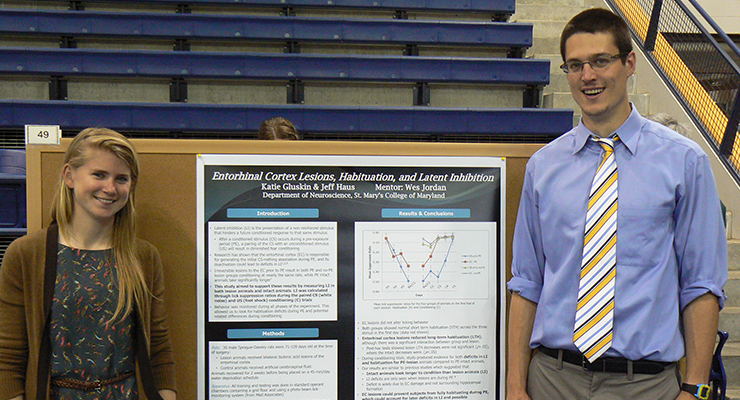
What is an SMP?
The St. Mary’s Project is a year-long, 8-credit, independently designed and executed course of study intended as a capstone experience for a student’s time at St. Mary’s. Working in close conjunction with one or more professors, you have the opportunity to explore, in depth, a question or idea that entrances and intrigues you. Many—although by no means all—SMPs are interdisciplinary, bringing together threads from earlier classes taken across the curriculum. The College has established certain guidelines for the SMP:
- It must be student-initiated
- It must demonstrate methodological competence (by identifying an area to be explored and proposing a method of inquiry appropriate for the topic)
- It must draw on and extend knowledge, skills of analysis, and creative achievement developed through previous academic work. It must include a reflection on the social context, the body of literature, or the conceptual framework to which the project is a contribution
- It must be shared with the larger community through some form of public presentation.
Neuroscience St. Mary’s Projects
Many students who are psychology, biology, or chemistry majors choose to complete their SMP on a neuroscience topic. In most cases, the SMP is completed in one of these disciplines but has a neuroscience focus. An SMP in neuroscience is not required for the minor, but is highly encouraged, particularly for students planning to continue their education at the graduate level. With coordinator approval, a neuroscience SMP can substitute for one of the upper division electives in the minor curriculum (NEUR 302).
SMP Process
First year students and sophomores:
- Consider your interests and keep track of favorite and interesting topics
- Don’t be too specific, keep it broad
- Talk to friends and seniors doing projects.
- Attend SMPs and look over the archives
First semester of junior year:
- Consider whether you want to collaborate with others. Note that collaborating with students will not necessarily make your work load easier
- Think about whether you want to do the project in two 4-credit blocks or employ some other sequence
Second semester of junior year:
- Narrow your choice to one or two topics
- Discuss and develop your topic ideas with faculty members who might be good mentors.
- Talk to the St. Mary’s Career Center if you want to include an off-campus component to your project.
- Decide if you will be collaborating with a fellow student.
- Have a good idea of what you want to do by advising day.
- Select a faculty mentor in the spring semester.
- Submit a formal proposal
Senior Year
- Work closely with your faculty mentor.
- Submit the budget request form by late October (option to resubmit in March).
- Complete research, hands-on experience, written essay, or poster.
- Present in the Spring semester
How to Choose a Topic
- What areas of neuroscience interest you?
- What are your career interests?
- Do you want a project to include specific experiences such as doing an off-campus internship or conducting on-site research?
- What was your favorite class and why?
- Would a topic from a class be something you would like to pursue further?
SMP Forms
SMP Resources
St. Mary’s Projects Website >>
Highlighted SMP Project
Stefania D’Ambrosio ‘14 and Nicole DeAngeli ‘14: “The effects of pre-exposure and D-cycloserine administration on extinction learning in the rat.”
Studies that address the effects of pre-exposure on extinction learning are limited and present conflicting results. Understanding how pre-exposure affects the ability to extinguish has major implications for the treatment of fear and anxiety disorders, and is therefore clinically relevant. Also relevant to fear and anxiety disorder treatment are drugs such as the NMDA partial agonist D-cycloserine (DCS). DCS enhances extinction learning in rats and exposure therapy in humans, but the mechanism by which it exerts these effect remains unclear. The present study seeks to elucidate (1) the effect of pre-exposure on extinction learning and (2) determine if DCS effects the retrieval of memories made prior to extinction or is simply acting only to enhance the extinction memory. We determined that pre-exposure in this experimental design results in retarded extinction (latent extinction). We also determined that DCS acts only on the extinction memory and does not impact or interact with prior memories.
